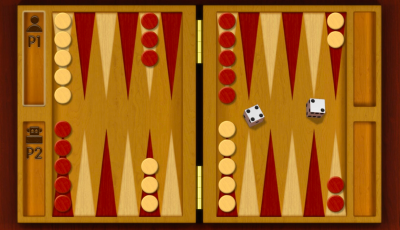Backgammon rules
Components
- A board with 24 narrow triangles called points, divided into four quadrants of six points each, alternating in color.
- 15 checkers for each player (white and red in our implementation).
- Two standard six-sided dice.
Objective
The goal is to be the first player to move all their checkers into their home board and then bear them off before the opponent does.
Board
Each side of the board has 12 triangles called points. The white player moves their checkers from the top right to the top left to the bottom left to the bottom right. The red player moves in the opposite direction.
For the white player, the top right triangle is called their 24-point. The bottom right triangle is their 1-point.
Setup
At the start of the game, the 15 checkers of a player are placed as follows:
- 2 on their 24-point
- 5 on their 13-point
- 3 on their 8-point
- 5 on their 6-point
Turns
A player rolls two dice at the beginning of each turn. A checker may move either the total of both dice in sequence, or two different checkers may each move according to one of the dice.
Throwing doubles (e.g. 3-3) allows the player to move four times the value of the die (e.g. four moves of 3).
A checker may move to any of the following, collectively called open points:
- A point that is unoccupied.
- A point that is occupied by the player’s own checkers.
- A point that is occupied by a single opposing checker (a blot).
Hitting checkers
If a checker lands on a blot, the opponent’s checker is hit and placed on the bar.
A checker on the bar must re-enter on the opponent’s home board before any other moves are made.
To re-enter, the player must roll a die showing a number corresponding to an open point in the opponent’s home board. If the player cannot re-enter, they lose their turn.
Bearing off
Once all of a player’s checkers are in their own home board (point 1 - 6), they may begin bearing off.
A player bears off by rolling a number that corresponds to the point with a checker, removing it from the board.
If no checker is on the rolled point, the player must move a checker from a higher point. If there are no checkers on higher points, the player may bear off the highest checker.
A player must use both dice if possible.
Game end
The game end when a player bears off all their 15 checkers.

